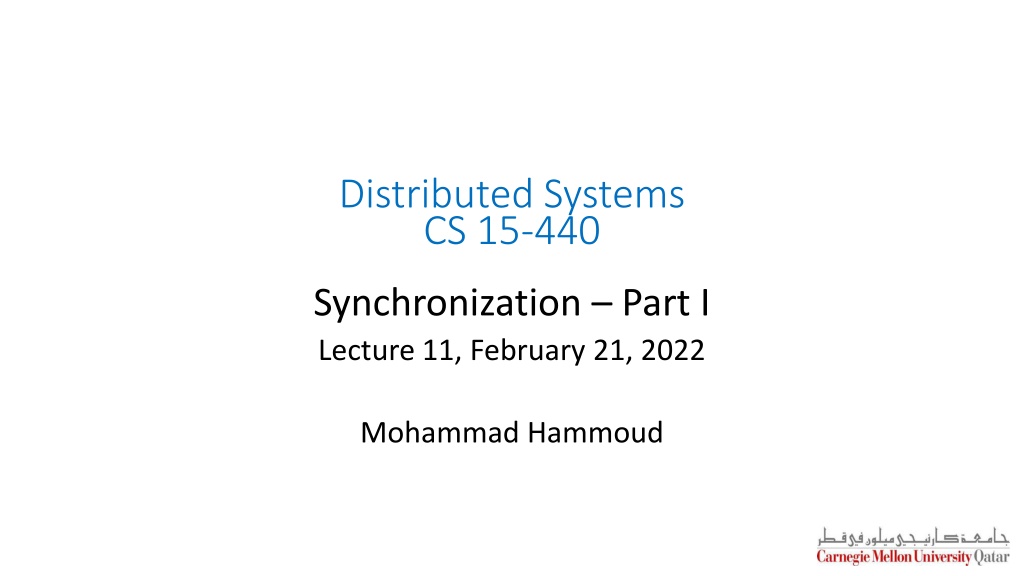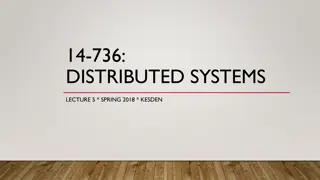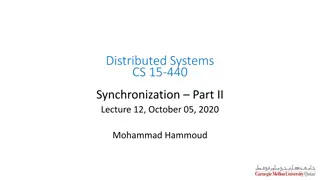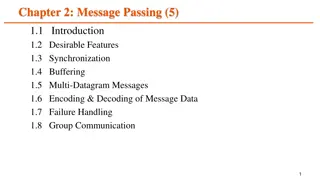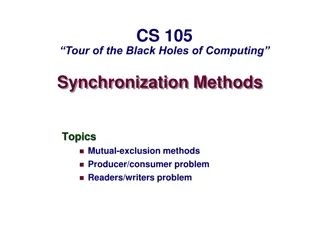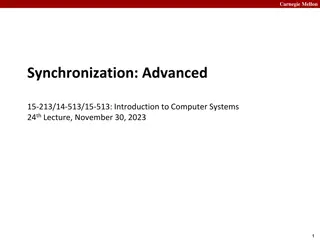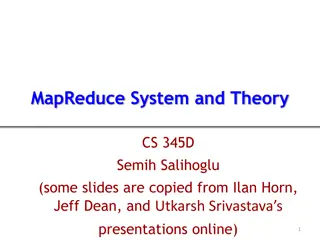Synchronization in Distributed Systems: Examples and Taxonomy
Understanding the need for synchronization in distributed systems is vital for ensuring correct operation. Examples such as vehicle tracking and file writing highlight the importance of entities coordinating and agreeing on events and resource access. A broad taxonomy of synchronization reasons is discussed, emphasizing the need for order agreement and resource sharing among entities. Key synchronization algorithms like Cristian's, Berkeley's, and NTP are highlighted, along with upcoming deadlines and session topics.
Download Presentation

Please find below an Image/Link to download the presentation.
The content on the website is provided AS IS for your information and personal use only. It may not be sold, licensed, or shared on other websites without obtaining consent from the author. Download presentation by click this link. If you encounter any issues during the download, it is possible that the publisher has removed the file from their server.
E N D
Presentation Transcript
Distributed Systems CS 15-440 Synchronization Part I Lecture 11, February 21, 2022 Mohammad Hammoud
Today Last Session Naming + Quiz I Today s Session Synchronization Coordinated Universal Time (UTC) Tracking Time on a Computer Clock Synchronization: Cristian s Algorithm, Berkeley Algorithm and Network Time Protocol (NTP) Announcements P1 is due today by midnight PS3 is out. It is due on Feb 24 by midnight Midterm is on March 9
Synchronization Until now, we have looked at: How entities can be organized and communicate with each other How entities are named and identified In addition to the above requirements, entities in DSs often have to cooperate and synchronize to solve a given problem correctly E.g., In a distributed file system, processes have to synchronize and cooperate such that two processes are not allowed to write to the same part of a file
Need for Synchronization Example 1 Vehicle tracking in a City Surveillance System using a Distributed Sensor Network of Cameras Objective: To keep track of suspicious vehicles Camera Sensor Nodes are deployed over the city Each Camera Sensor that detects a vehicle reports the time to a central server Server tracks the movement of the suspicious vehicle 1:12 PM: 1:08 PM: Car spotted Car spotted 1:05 PM: Car spotted Car spotted 1:16 PM: If the sensor nodes do not have a consistent version of the time, the vehicle cannot be reliably tracked 1:25 PM: 1:15 PM: Car spotted Car spotted 3:00 PM: 1:00 PM: Car spotted Car spotted 1:17 PM: Car spotted Car spotted 1:18 PM:
Need for Synchronization Example 2 Writing a file in a Distributed File System Client A Server Client C Write data1 to file abc.txt at offset 0 Distributed File abc.txt Write data3 to file abc.txt at offset 1 Client B Write data2 to file abc.txt at offset 1 If the distributed clients do not synchronize their write operations to the distributed file, then the data in the file can be corrupted
A Broad Taxonomy of Synchronization Reason for synchronization and cooperation Entities have to agree on ordering of events Entities have to share common resources E.g., Vehicle tracking in a Camera Sensor Network; Financial transactions in Distributed E- commerce Systems E.g., Reading and writing in a Distributed File System Examples Entities should have a common understanding of time across different computers Entities should coordinate and agree on when and how to access resources Requirement for entities Mutual Exclusion Time Synchronization Topics we will study
Overview Today s lecture Time Synchronization Physical Clock Synchronization (or, simply, Clock Synchronization) Here, actual time on computers are synchronized Logical Clock Synchronization Computers are synchronized based on relative ordering of events Mutual Exclusion How to coordinate between processes that access the same resource? Election Algorithms Here, a group of entities elect one entity as the coordinator for solving a problem Next two lectures
Overview Time Synchronization Clock Synchronization Logical Clock Synchronization Mutual Exclusion Election Algorithms
Clock Synchronization Clock synchronization is a mechanism to synchronize the time of all the computers in a DS We will study: Coordinated Universal Time Tracking Time on a Computer Clock Synchronization Algorithms Cristian s Algorithm Berkeley Algorithm Network Time Protocol
Clock Synchronization Coordinated Universal Time Tracking Time on a Computer Clock Synchronization Algorithms Cristian s Algorithm Berkeley Algorithm Network Time Protocol
Coordinated Universal Time (UTC) All the computers are generally synchronized to a standard time called Coordinated Universal Time (UTC) UTC is the primary time standard by which the world regulates clocks and time UTC is broadcasted via the satellites UTC broadcasting service provides an accuracy of 0.5 msec Computer servers and online services with UTC receivers can be synchronized by satellite broadcasts Many popular synchronization protocols in distributed systems use UTC as a reference time to synchronize clocks of computers
Clock Synchronization Coordinated Universal Time Tracking Time on a Computer Clock Synchronization Algorithms Cristian s Algorithm Berkeley Algorithm Network Time Protocol
Tracking Time on a Computer How does a computer keep track of its time? Each computer has a hardware timer The timer causes an interrupt H times a second The interrupt handler adds 1 to its Software Clock (C) Issues with clocks on a computer In practice, the hardware timer is imprecise It does not interrupt H times a second due to material imperfections of the hardware and temperature variations The computer counts the time slower or faster than actual time Loosely speaking, Clock Skew is the skew between: the computer clock and the actual time (e.g., UTC)
Clock Skew When the UTC time is t, let the clock on the computer have a time C(t) Three types of clocks are possible Perfect clock: The timer ticks H interrupts a second dC/dt = 1 Fast clock: The timer ticks more than H interrupts a second dC/dt > 1 Slow clock: The timer ticks less than H interrupts a second dC/dt < 1 dC/dt > 1 dC/dt = 1 15 Clock time, Cp(t) 10 7 dC/dt < 1 10 0 UTC, t
Clock Skew (contd) Frequency of the clock is defined as the ratio of the number of seconds counted by the software clock for every UTC second Frequency = dC/dt Skew of the clock is defined as the extent to which the frequency differs from that of a perfect clock Skew = dC/dt 1 dC/dt > 1 dC/dt = 1 Clock time, Cp(t) Hence, 0 for fast a clock dC/dt < 1 = 0 perfect a for clock Skew 0 for slow a clock UTC, t
Maximum Drift Rate of a Clock The manufacturer of the timer specifies the upper and the lower bound that the clock skew may fluctuate. This value is known as maximum drift rate ( ) 1 <= dC/dt <= 1 + How far can two clocks drift apart? If two clocks are drifting from UTC in the opposite direction, at a time t after they were synchronized, they may be as much as 2 t seconds apart Guaranteeing maximum drift between computers in a DS If maximum drift permissible in a DS is seconds, then clocks of every computer must be resynchronized at least every /2 seconds
Clock Synchronization Coordinated Universal Time Tracking Time on a Computer Clock Synchronization Algorithms Cristian s Algorithm Berkeley Algorithm Network Time Protocol
Cristians Algorithm Flaviu Cristian (in 1989) provided an algorithm to synchronize networked computers with a time server The basic idea: Identify a network time server that has an accurate source for time (e.g., the time server has a UTC receiver) All the clients contact the network time server for synchronization However, the network delays incurred when the client contacts the time server results in outdated time The algorithm estimates the network delays and compensates for it
Cristians Algorithm Approach Client Cli sends a request to Time Server Ser, time stamped its local clock time T1 Ser will record the time of receipt T2 according to its local clock dTreq is network delay for request transmission Time Server Ser T2 T3 T1 T1, T2, T3 T1 T4 Client Cli dTreq dTres Ser replies to Cli at its local time T3, piggybacking T1 and T2 Cli receives the reply at its local time T4 dTres is the network delay for response transmission Now Cli has the information T1, T2, T3 and T4 Assuming that the transmission delay from Cli same T2-T1 T4 T3 Ser and Ser Cli are the
Christians Algorithm Synchronizing Client Time Client C estimates its offset relative to Time Server S = T3 + dTres T4 = T3 + ((T2-T1)+(T4-T3))/2 T4 = ((T2-T1)+(T3-T4))/2 T2 T3 S C T1 T4 dTreq dTres If > 0 or < 0, then the client time should be incremented or decremented by seconds Gradual Time Synchronization at the client Instead of changing the time drastically by seconds, typically the time is gradually synchronized The software clock is updated at a lesser/greater rate whenever timer interrupts Note: Setting clock backward (say, if < 0)is not allowed in a DS since decrementing a clock at any computer has adverse effects on several applications (e.g., make program)
Cristians Algorithm Discussion 1. Assumption about packet transmission delays Cristian s algorithm assumes that the round-trip times for messages exchanged over the network are reasonably short The algorithm assumes that the delay for the request and response are equal Will the trend of increasing Internet traffic decrease the accuracy of the algorithm? Can the algorithm handle delay asymmetry that is prevalent in the Internet? Can the clients be mobile entities with intermittent connectivity? Cristian s algorithm is intended for synchronizing computers within intranets 2. A probabilistic approach for calculating delays There is no tight bound on the maximum drift between clocks of computers 3. Time server failure or faulty server clock Faulty clock on the time server leads to inaccurate clocks in the entire DS Failure of the time server will render synchronization impossible
Clock Synchronization Coordinated Universal Time Tracking Time on a Computer Clock Synchronization Algorithms Cristian s Algorithm Berkeley Algorithm Network Time Protocol
Berkeley Algorithm Berkeley algorithm is a distributed approach for time synchronization Approach: 1. A time server periodically (approx. once in 4 minutes) sends its time to all the computers and polls them for the time difference 2. The computers compute the time difference and then reply 3. The server computes an average time difference for each computer 4. The server commands all the computers to update their time (by gradual time synchronization) 3:00 3:00 3:00 3:05 +0:00 +0:05 Time server +0:15 -0:20 -0:10 +0:25 2:50 3:05 3:25 3:05
Berkeley Algorithm Discussion 1. Assumption about packet transmission delays Berkeley s algorithm predicts network delay (similar to Cristian s algorithm) Hence, it is effective in intranets, and not accurate in wide-area networks 2. No UTC Receiver is necessary The clocks in the system synchronize by averaging all the computer s times 3. Decreases the effect of faulty clocks Fault-tolerant averaging, where outlier clocks are ignored, can be easily performed in Berkeley Algorithm 4. Time server failures can be masked If a time server fails, another computer can be elected as a time server
Clock Synchronization Coordinated Universal Time Tracking Time on a Computer Clock Synchronization Algorithms Cristian s Algorithm Berkeley Algorithm Network Time Protocol
Network Time Protocol (NTP) NTP defines an architecture for a time service and a protocol to distribute time information over the Internet In NTP, servers are connected in a logical hierarchy called synchronization subnet The levels of synchronization subnet is called strata Stratum 1 servers have most accurate time information (connected to a UTC receiver) Servers in each stratum act as time servers to the servers in the lower stratum
Hierarchical organization of NTP Servers This stratum contains the primary servers that are directly connected to the UTC receivers Stratum 1 Stratum 2 are secondary servers that are synchronized directly with primary servers Stratum 2 More accurate time Stratum 3 Stratum 3 synchronizes with Stratum 2 servers End user computers synchronize with the servers in the upper layer stratum Last stratum
Operation of NTP Protocol When a time server A contacts time server B for synchronization If stratum(A) <= stratum(B), then A does not synchronize with B If stratum(A) > stratum(B), then: Time server A synchronizes with B An algorithm similar to Cristian s algorithm is used to synchronize. However, larger statistical samples are taken before updating the clock Time server A updates its stratum stratum(A) = stratum(B) + 1
Discussion of NTP Design Accurate synchronization to UTC time NTP enables clients across the Internet to be synchronized accurately to the UTC Large and variable message delays are tolerated through statistical filtering of timing data from different servers Scalability NTP servers are hierarchically organized to speed up synchronization, and to scale to a large number of clients and servers Reliability and Fault-tolerance There are redundant time servers, and redundant paths between the time servers The architecture provides reliable service that can tolerate lengthy losses of connectivity A synchronization subnet can reconfigure as servers become unreachable. For example, if Stratum 1 server fails, then it can become a Stratum 2 secondary server Security NTP protocol uses authentication to check of the timing message originated from the claimed trusted sources
Summary of Clock Synchronization Physical clocks on computers are not accurate Clock synchronization algorithms provide mechanisms to synchronize clocks on networked computers in a DS Computers on a local network use various algorithms for synchronization Some algorithms (e.g, Cristian s algorithm) synchronize time by contacting centralized time servers Some algorithms (e.g., Berkeley algorithm) synchronize in a distributed manner by exchanging the time information on various computers NTP provides architecture and protocol for time synchronization over wide- area networks such as the Internet
Next Class Logical Clocks: Lamport s Clock Vector Clocks Mutual Exclusion How to coordinate between processes that access the same resource?
